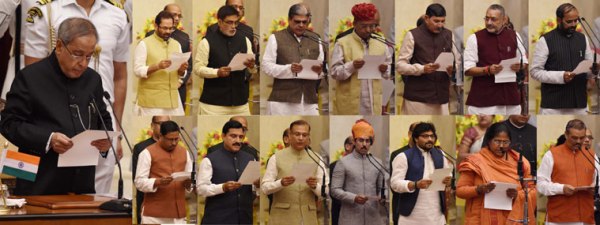A fortnight short of completing six months as Prime Minister, Narendra Modi expanded his Cabinet today keeping the imperatives of both governance and politics in mind. So as he brought in 21 new faces and effected changes in the leadership of key ministries, his political calculations in his choice of ministers was also aimed at spreading the party’s footprint in crucial states heading to polls.
The most significant changes in today’s reshuffle were the shifting of D V Sadananda Gowda from the high-profile Railways to Law and Justice — his job was given to BJP’s latest import and PM’s trusted G20 sherpa Suresh Prabhu — and induction of former Goa Chief Minister Manohar Parrikar as Defence Minister. Health Minister Harsh Vardhan was shifted to low-profile Science and Technology, Earth Sciences but this move is being viewed as a move to make him the face of BJP’s Delhi Assembly campaign when elections are held early next year. His place in the Health MInistry has been allocated to J P Nadda.
Finance and Corporate Affairs Minister Arun Jaitley, who hands over the Defence Ministry to former Goa CM Manohar Parrikar, maintains his pre-eminent position in the government, taking on Information and Broadcasting from Prakash Javadekar. Former Army chief Gen V K Singh, who had a spate of tussles with successive secretaries has been relieved of the charge of Development of North-Eastern Region while Gautam Budh Nagar MP Mahesh Sharma, considered close to the RSS, was made Minister of State (Independent charge), Culture and Tourism as well as MoS, Civil Aviation.
Among the Cabinet ministers, Nitin Gadkari has been relieved of Rural Development which will now be handled by Birender Singh, who will also be Minister of Panchayati Raj, Drinking Water and Sanitation, while Communications and Information Technology Minister Ravi Shankar Prasad has been relieved of Law and Justice.
On the political front, the expansion lays down a roadmap for the party to establish itself as a credible alternative to entrenched parties in states where the BJP isn’t the main player, including Bihar and Punjab where it is part of the ruling alliance with the Shiromani Akali Dal (Badal).
This probably explains why a figure as controversial as Bihar leader Giriraj Singh, a Bhumihar, who was among the first leaders to lend his voice to the Modi-as-PM chant and who said that Modi’s critics should go to Pakistan, has been rewarded with the post of minister of state.

The expansion was overshadowed by the pullout of the BJP’s oldest ally Shiv Sena. Miffed over Modi’s decision to induct one of its leaders, Suresh Prabhu, without its consent, the Sena stopped its member Anil Desai from joining the government. Prabhu quit the Sena and joined the BJP hours before he took oath as a cabinet minister.
Modi has also tried to balance caste equations, especially in states like Bihar, Uttar Pradesh and Punjab, which go to polls over the next three years. Thus, a minister of state (independent charge) to a Brahmin — Gautam Buddha Nagar MP Mahesh Sharma — is a signal to Brahmins of Uttar Pradesh who are disenchanted with both BSP and the Samajwadi Party and are unable to find any solace in the Congress.
0 comments:
Post a Comment